What we do
Services
Experts in
This story started 27 years ago when an entrepreneur put a broken laser pointer up for sale on a small auction website. Can you believe someone bought such a useless thing for $15? Yes, it turns out there are people who collect broken laser pointers and are ready to spend their money on auctions like this. While this story seems trivial and amusing, it describes the first steps to success taken by one of the world’s richest P2P commerce business owners. The person that started the auction was Pierre Omidyar, the billionaire founder of the eBay peer-to-peer marketplace.
Such stories amaze and inspire. Isn’t it the type of experience every modern entrepreneur dreams about?
Looking for ways to succeed, business owners search for the most viable niche and consult with tech experts and industry trendsetters on how to launch a business that will outmatch all competitors. On their way, they may discover the P2P business model.
Nowadays, using the power of the internet, you can make money from things you don’t own. Just think about it:
Airbnb lets users stay at one of 4.5 million properties worldwide while owning none of them.
Uber, the ride-sharing startup, gains money from organizing trips without actually having to invest in fuel or vehicles.
Upwork demonstrates specialists’ profiles while working with none of them.
Whitelance is a platform for creating marketplaces. It allows businesses to quickly launch online platforms by offering their own white-label solution. We took part in the development of Whitelance, so we had to dive deep into the topic of marketplaces. Today, we’re ready to share our experience, vision, and best practices on how to break into the market of peer-to-peer ecommerce.
To start our journey, let’s define what a P2P marketplace is.
A peer-to-peer marketplace is one of the most popular e-commerce development trends. It’s a two-sided marketplace where individuals that provide products or services meet potential clients or customers. The platform eliminates the distance between them, and any user can play both roles. For example, you can lease your New York apartment on Airbnb and book a room with a delightful view somewhere on the Amalfi Coast at the same time. You can play two roles simultaneously using the same platform.
Let’s have a look at the main types of peer-to-peer marketplaces.
Peer-to-peer marketplaces can be divided into several types, and understanding these distinctions is crucial when engaging marketplace development services. Let’s take a look at the most common classifications.
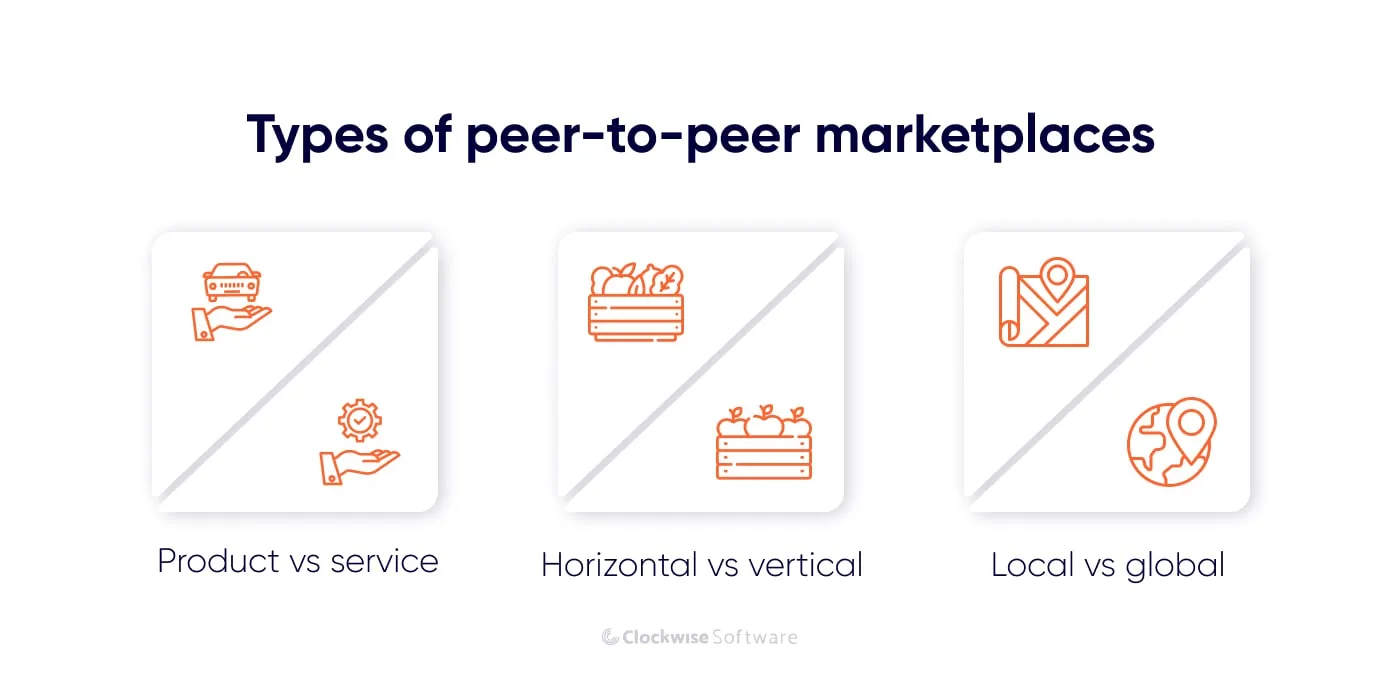
Product marketplaces are e-commerce platforms that connect sellers with consumers interested in buying their products, which can be physical or downloadable.
Service marketplaces offer a place for service providers and their customers to meet and cooperate under beneficial conditions.
Horizontal marketplaces offer numerous types of products and services without sticking to a certain niche. Some world-famous examples of horizontal marketplaces are Amazon and AliExpress, where users can find anything from garments to furniture to software.
Vertical marketplaces target specific user groups and can be divided into hundreds types. For example, HipStamp and Delcampe are product P2P marketplaces where collectors can buy and sell stamps. Automotive peer-to-peer marketplaces like Cars.com are also vertical product marketplace platforms.
Airbnb, Booking.com, and Vrbo are examples of rental platforms where users can either offer property for rent or search for properties to rent. Car sharing platforms are another type of vertical service marketplace. These are websites or apps where drivers and fellow passengers connect with each other in order to spread the cost of trips. One of the most famous apps of this type is BlaBlaCar. These are only several examples of vertical marketplaces, and it’s impossible to name all of them.
Marketplaces can also be characterized by the markets in which they operate. Local P2P marketplaces work in a particular country or region. OTTO is a local German marketplace.
Global peer-to-peer platforms like Amazon and Airbnb are accessible from most places in the world.
The P2P marketplaces we gave as examples above have thousands to hundreds of millions of users. Why are P2P platforms that popular? We describe the reasons in the next section.
The peer-to-peer model is beneficial for all users, without exceptions. Let’s see why sellers and service providers as well as consumers prefer using peer-to-peer marketplaces.
Peer-to-peer marketplaces bring benefits not only to their users. We’ve already mentioned that building an online marketplace of this type is also beneficial for entrepreneurs. Below, we describe the five main advantages you get when developing a marketplace platform.
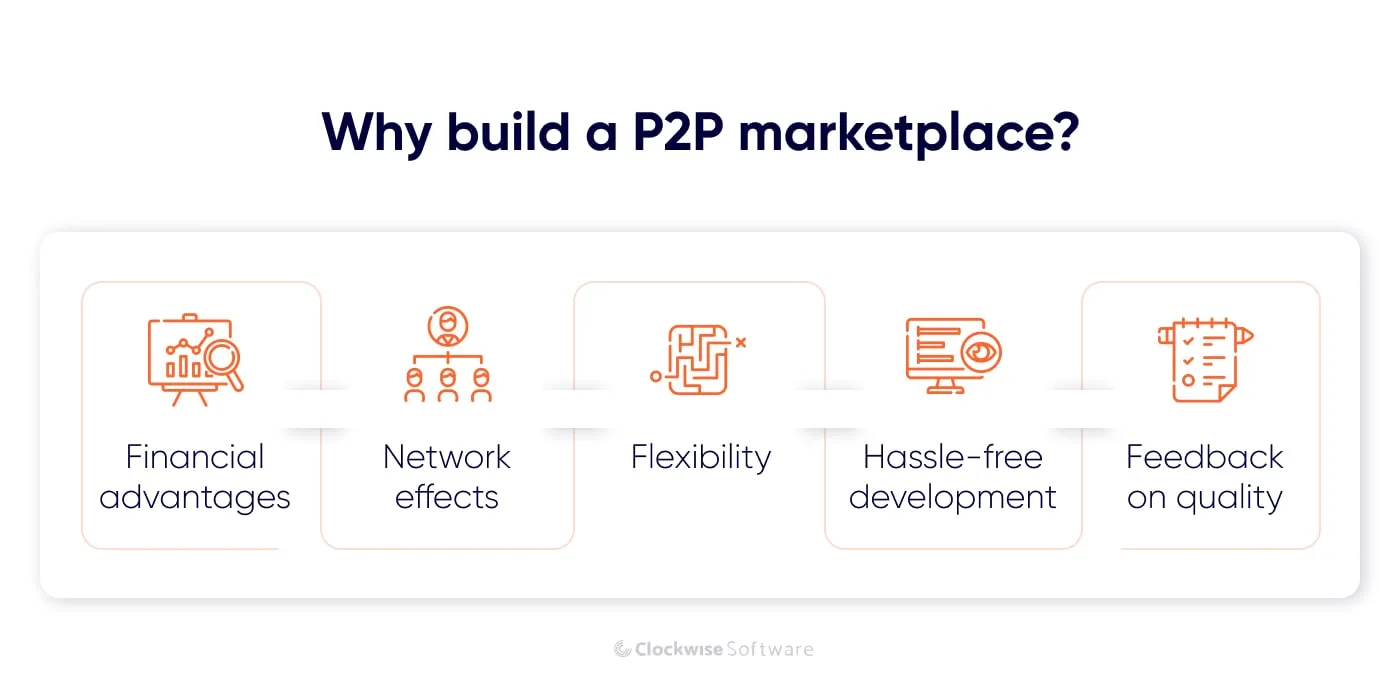
Peer-to-peer marketplace software allows you to make a profit by focusing on software development and maintenance. There’s no need to set up production or worry about shipping issues; your task is to launch a software solution, add exceptional functionality, and attract your first visitors. After that, they will do the rest for you. You can focus on improving your marketplace while your bank account balance grows.
Marketplace visitors attract each other: high-quality products make customers turn their heads toward your website, and sellers come to your marketplace due to a constantly growing number of potential buyers. This is called the network effect: each new user on either side brings more value to those users who already utilize the platform. For example, a new seller adds to the choice for consumers, while a new consumer is another potential buyer for every marketplace seller.
You can change your industry, niche, or marketplace specifics anytime you want: you don’t produce any goods and don’t invest in manufacturing, so you have a degree of flexibility most businesses can only dream about. You can even convert your platform into a white-label marketplace and sell the technology behind it to other businesses to get an additional revenue stream. This is also a good option if you get tired of running your marketplace on your own but don’t want to lose your profits.
The number of software development companies that can deliver a superb software solution can hardly be overestimated. Even if you’re not tech-savvy, you can easily delegate development and testing tasks to an outsourcing team with a background in online marketplace development.
Although you’re not the one who’s responsible for product quality, you can ensure goods and services are of decent quality using your marketplace’s functionality. Develop a rating system, allow customers to evaluate products and buyers, and allow them to post text, photo, and video reviews.
These features have the potential to boost e-commerce and on-demand businesses. By investing in P2P solutions, you gain an opportunity to level up your company and make higher profits than ever before.
In addition to deciding on the business side of your peer-to-peer marketplace, you should pay attention to the development process. Developing software in the right sequence allows you to create a high-quality product at a reasonable cost and without excessive effort. There are six key steps you should take to build a P2P marketplace that will be able to compete in the market: planning, discovery phase, UI/UX design, application architecture, development and testing, and further development.
You’ve already performed some planning activities when you decided to build a peer-to-peer marketplace. When choosing this type of software, you have to understand what niche you want to fill and who your target audience will be. However, you should also spend time deciding on the marketplace business model for your platform. It’s best to opt for a model that will be beneficial for a beginner marketplace and allow you to scale at the same time. We cover the topic of monetization in detail in the following sections.
The discovery phase aims at streamlining the development process of your peer-to-peer online marketplace. It starts with a business analyst setting up several meetings with you as the project stakeholder and clarifying all your requirements and expectations. Then, the BA prepares a list of documents that regulate the development process. These include a software requirements specification (SRS), feature breakdown structure, development plan, test plan, and a cost estimate with the predicted cost to develop the web app you want.
The discovery phase is also a proven way to validate your business idea if you haven’t done this before. During this phase, your development team works on a proof of concept and product prototype to check your product’s business viability and technical feasibility. All in all, the discovery phase allows you to wisely plan your project and your budget.
An intuitive marketplace platform design is crucial for customer satisfaction, so it’s important to create a design your users will love. In the case of a peer-to-peer marketplace platform, it’s important to remember that you have two groups of users: sellers or service providers and buyers or customers. That’s why you should think through user interfaces for both user groups. An experienced UI/UX designer will help you create a design that adds value to your platform.
The application architecture is the basis of robust software, and it’s important to decide on your P2P marketplace architecture before starting actual development. A software architect is responsible for creating a scalable architecture and choosing the most effective technology stack of your project. Once the architecture is approved, it’s time to move to development.
In most cases, development starts with building a minimum viable product, or an MVP, of your peer-to-peer marketplace. Starting with an MVP, you take small steps and follow an iterative development process to create a product that will satisfy your target audience’s basic needs. Such an approach helps you save your budget and helps you learn from user feedback before making crucial decisions. Starting with an MVP is also a good idea if you want to raise funds for a marketplace startup.
While software engineers develop new functionality, QA engineers test it simultaneously to quickly notice bugs and fix them right away.
Once the MVP of your peer-to-peer marketplace is ready, you should start testing it on real users. During this process, you might find bugs that weren’t detected earlier. You should also ask the first adopters of your platform to leave feedback, which you can use as the basis for further development. This further development allows you to upgrade your P2P platform, add new features, and improve existing ones.
But what features should you start with? We describe the crucial functionality of a peer-to-peer marketplace in the next section.
Even though the P2P marketplace model has proven viable, it takes effort to make your marketplace successful. One way to do this is to offer marketplace users the functionality they need.
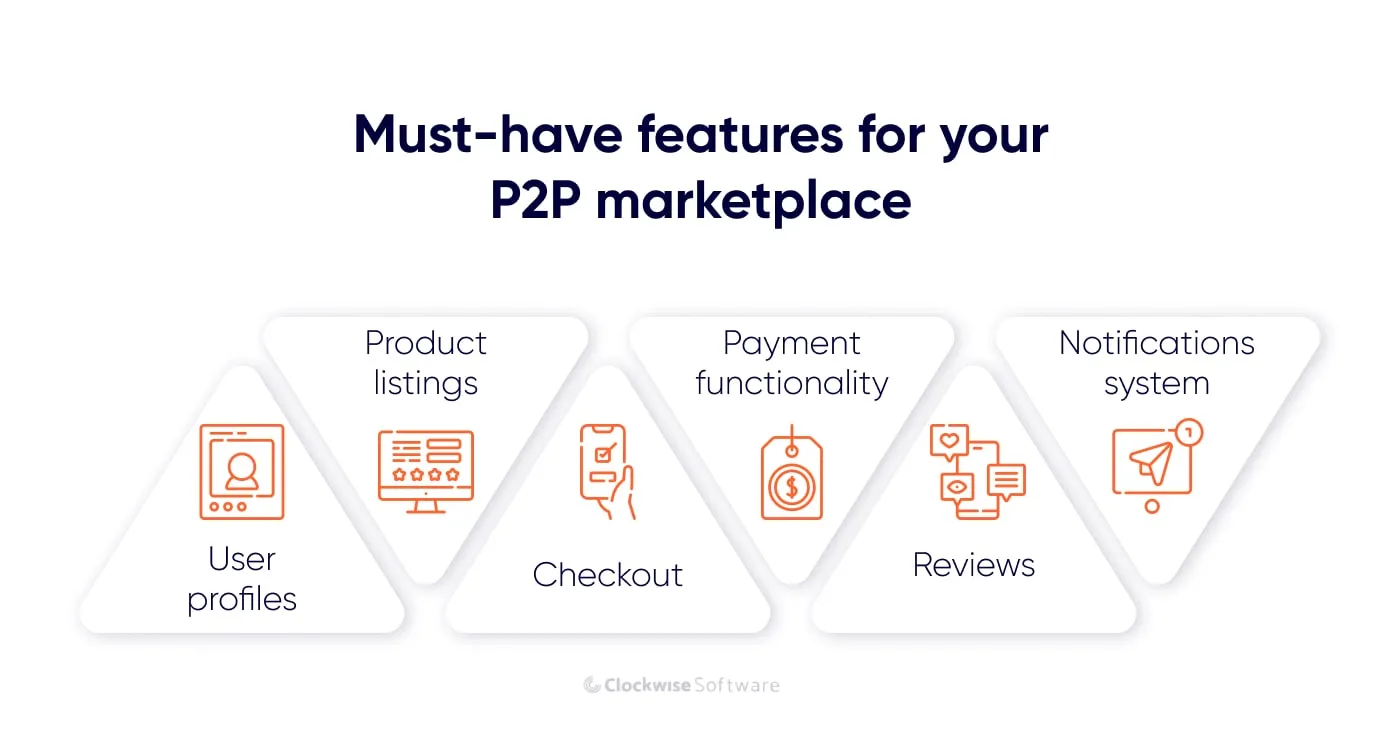
Make sure your peer-to-peer marketplace business plan includes a section devoted to these features:
Both parties to your marketplace should have an opportunity to create profiles as quickly and easily as possible. Customers’ and sellers’ user interfaces (UIs) should differ, and so should the information users need to provide and work with.
Quick tip: In your peer-to-peer marketplace software, enable users to export data from their social media profiles to save time and simplify the sign-in process.
This feature allows for adding products or services to the website. Providers should be able to add, remove, edit, publish, and delete items. In turn, customers should be able to review, comment on, and rate items, place bids, and purchase products.
Quick tip: Allow vendors to customize their listings. This will help customers to identify their brand and increase vendor loyalty.
Whether your marketplace offers products for sale or for temporary use, you need to make the purchase process smooth by launching a simple checkout page for customers.
Quick tip: Implement best practices such as allowing guest checkout, offering numerous payment options, and using a progress indicator to make a great checkout page.
Customers need to be able to pay for their purchases or bookings right on your marketplace. To offer this, integration with different payment gateways is essential. Make sure to allow different types of payments, including cryptocurrency and country-specific payment options.
Quick tip: Pay close attention to security and payment regulations. An escrow service may be handy: it helps buyers and sellers build trusting relationships and makes sure both parties fulfill their obligations.
Reviews are an excellent way to create a sense of trust and filter providers on your marketplace: Those that get positive reviews and high ratings will stay, and those who demonstrate lower quality will leave.
Quick tip: Moderate reviews, try to understand existing customers’ needs and wishes, and improve your marketplace according to customers’ expectations.
To speed up interactions and make communication between parties seamless, build notifications functionality.
Quick tip: Let your marketplace users choose the most convenient channel to get notifications. Provide not only in-app peer-to-peer marketplace notifications but also offer to send updates to a user’s email, favorite messenger, phone, etc.
Besides thinking through the main features of your new P2P marketplace, it’s important to solve some business and technical issues before starting development. In particular, you need to decide how to attract the first customers, how to monetize your business, and what technologies to choose for building your marketplace platform.
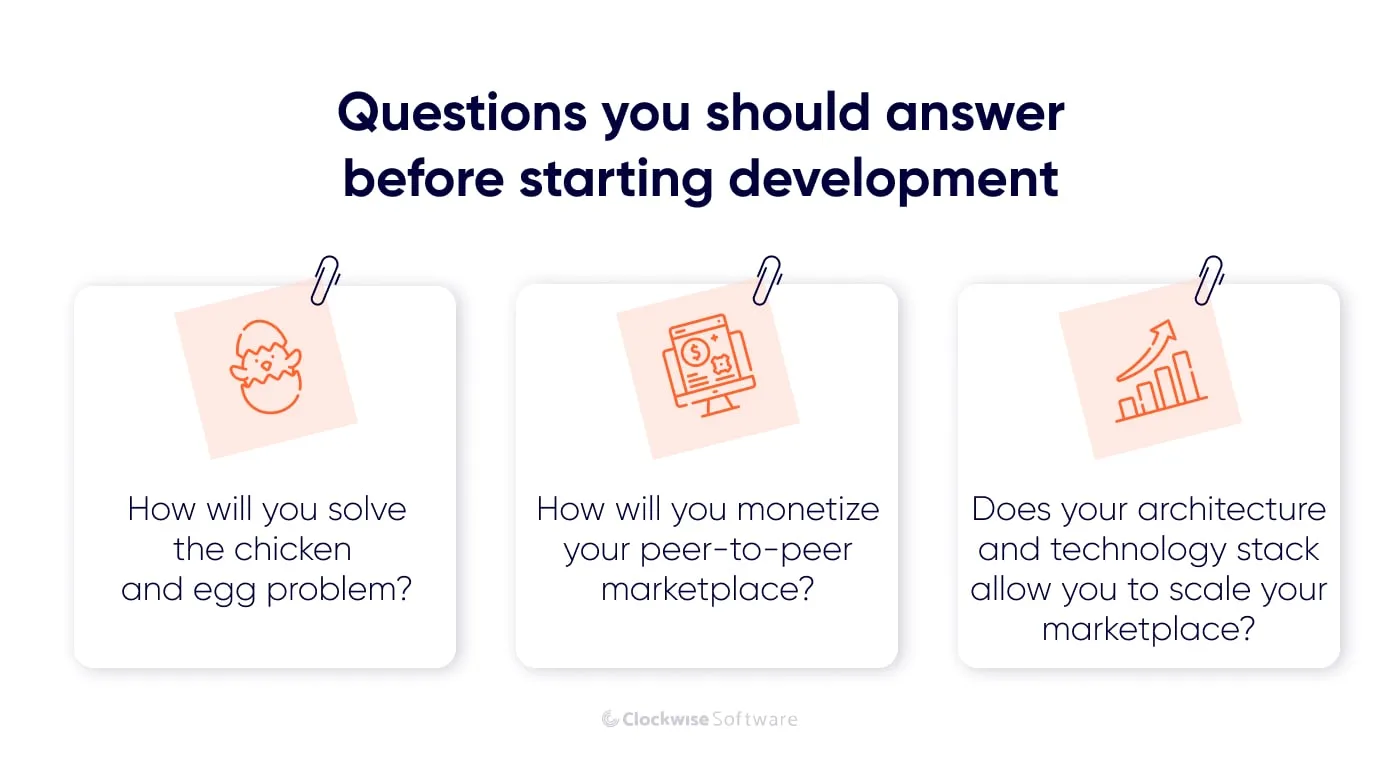
The chicken and egg problem is a typical challenge for every marketplace owner. It’s always hard to decide who you need to attract first and how to do it. Luckily, there are several common strategies that can help you solve the chicken and egg problem.
A tried and tested trick is to launch a landing page with an announcement, advertising, and a marketplace description. On this landing page, you can offer attractive early-bird bonuses and collect information on potential customers. Later on, when you launch your marketplace, you will already have a base of early customers!
Another useful tip is to offer benefits in exchange for sharing feedback on social media. Such a model will help you spread the word about your online platform.
Once you manage to attract the first users to your P2P marketplace, you’ll be one step closer to achieving network effects that add value to your e-commerce platform.
The bigger your P2P marketplace becomes, the more revenue it will bring in. However, you need to choose a monetization model that will be able to scale together with your platform.
You can choose among several models to monetize your peer-to-peer marketplace. The most common models applicable to marketplace monetization are commission, subscriptions, listing fees, featured listings, lead fees, freemium, and paid advertisements. You can also combine several P2P business models to find the perfect match for your platform.
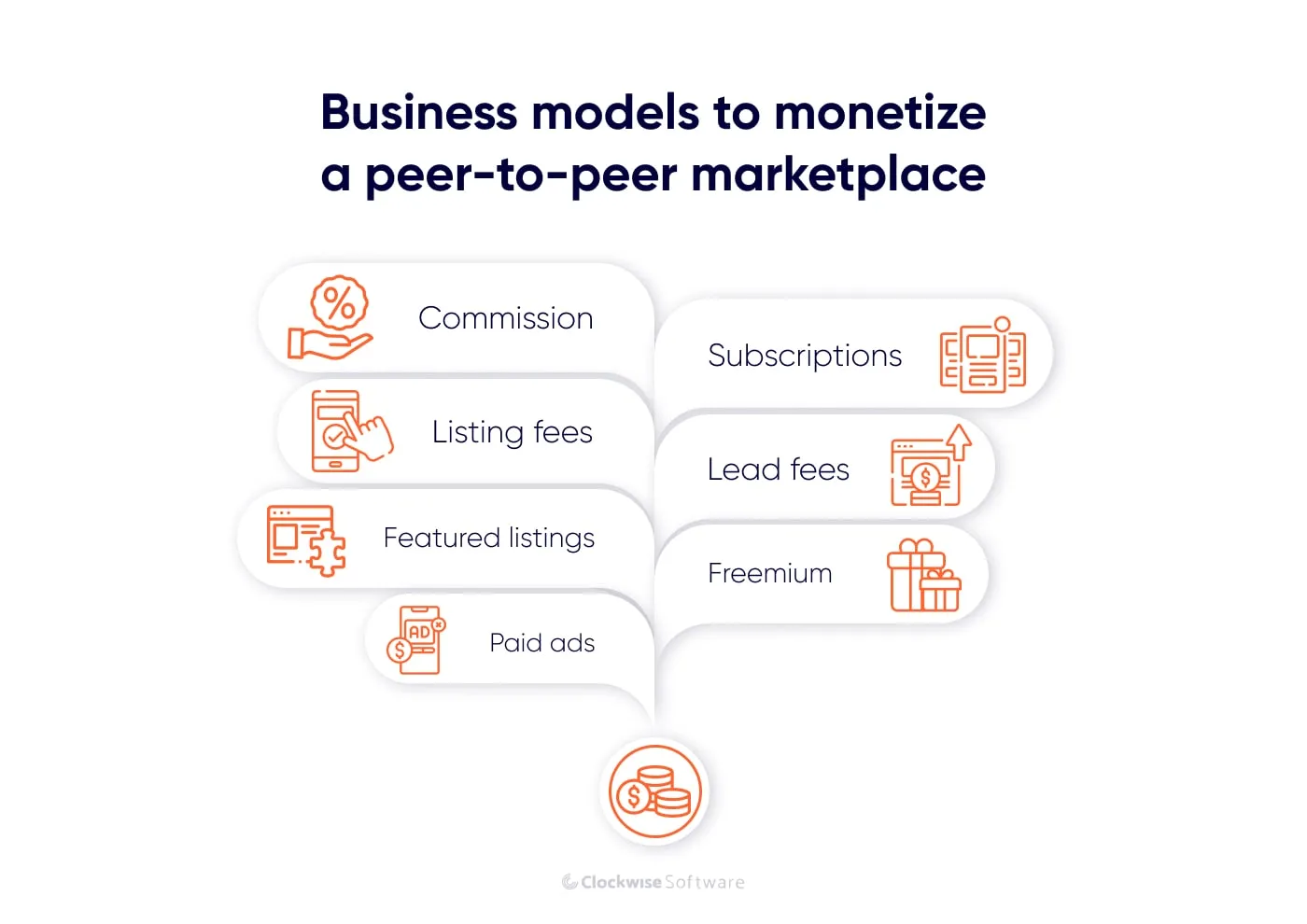
The commission-based business model is the most popular monetization model for marketplaces. To secure revenue, a marketplace owner charges either a percentage or a set fee for transactions made on the marketplace platform. As a rule, the fee applies to sellers.
The subscription model suits marketplaces that can communicate clear value for users even before they start using the platform. However, providing value in advance is a difficult task, so not many marketplaces can apply this model effectively. With the subscription model, you charge P2P marketplace users a set monthly or yearly fee in exchange for using all the platform’s functionality.
A listing fee is a monetization model that charges sellers for every listing they place on the platform. Of course, not every listing results in a purchase, so marketplaces that apply this model should prove the expediency of such payments.
There are also featured listings. On marketplaces with this monetization model, sellers can post their listings for free. However, if they want to make their products more visible and increase the chances of purchase, they can pay to feature their listings at the top of search results.
With the freemium model, users can take advantage of basic services for free while paying a fee for using additional services or features. With P2P marketplaces, this model can work like this: sellers and service providers have a limit for posting free listings (or posting listings in certain categories), and if they go over the limit, they need to pay. However, just like with the previous model, marketplace owners should offer a lot of value for the paid functionality; otherwise, they can’t expect a lot of people to use their paid services.
Charging a lead fee isn’t a typical business model for peer-to-peer marketplaces, but it can fit some specific business cases. The lead fee is charged from service providers only when they contact a potential customer. This model pays off if the deal is worth a lot of money. Moreover, there’s a risk that once a vendor and a buyer/customer contact each other, they can move their communication to another platform to avoid on-site transactions. Keep this in mind when working on your marketplace business plan.
Paid ads are a business model where you show your users banner ads while allowing them to use your platform for free. In this case, you get revenue from companies that place ads on your P2P marketplace.
Your choice of marketplace business model for your peer-to-peer marketplace will depend on your platform’s type. Some platforms work better with listing fees, while others successfully apply the freemium model. However, the commission-based model is considered the most applicable for monetizing P2P platforms.
The right application architecture is the basis of high-quality software. Based on our experience, we recommend using Amazon Web Services (AWS) to build a robust architecture that easily scales according to the demands of your business. Here are just several proven AWS services we use in our projects to ensure scalability:
Choosing AWS services to build your peer-to-peer marketplace creates the foundation for a robust platform that can easily grow in the future.
Peer-to-peer e-commerce products have started a new era in the global economy. They are key components of the sharing economy. P2P marketplace development isn’t just something that can bring you earnings right after you launch a solution. This is your chance to build a successful and profitable business in the long run.
Brainstorm a unique idea and find your place in a viable niche, build cooperation with competent IT engineers, and launch a product as soon as possible to be ahead of competitors from the very beginning.
